Sangliers Aywaille Rally
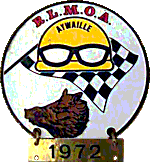
Aywaille
Aywaille is a Belgian municipality in the northern part of the Ardennes. It sits in the Walloon province of Liège, about 25km from the renowned Spa Francorchamps circuit.
The Boar of the Ardennes
The Ardennes is a well-known forested region of southeast Belgium extending into Luxembourg, Germany and France. Its rugged terrain encompasses rolling valleys, meandering rivers and extensive caves, as well as dense forests criss-crossed with hiking trails.
A view of the charming little town of Aywaille watered by the Ambleve river, where the Sangliers rally took place in the 1970s on the occasion of the Belgian Motorcycle Grand Prix
Forever linked with the history of this region is the indigenous wild boar.
'The Boar of the Ardennes' is the nickname given to Ambiorix, a young Gallic chief of the Eburones, (a Gallic people who lived in the north of Gaul), and who led a heroic resistance against Roman invaders in the heart of the Ardennes forest.
He was one of Julius Caesar's most formidable and fierce adversaries and is hailed as a national hero in Belgium, as is Vercingetorix in France.
In 54BC, Ambiorix defeated several lieutenants of Caesar and went on to attack General Quintus Ciceron, brother of the orator Cicero, who managed to resist the attack until he was relieved by the arrival of Caesar and his troops. Subsequently beaten by Caesar himself in the same year, Ambiorix managed to escape and lead a guerrilla war in the forests of the Ardennes massif. Then he mysteriously disappeared. He was nicknamed 'The Wild Boar of the Ardennes'.
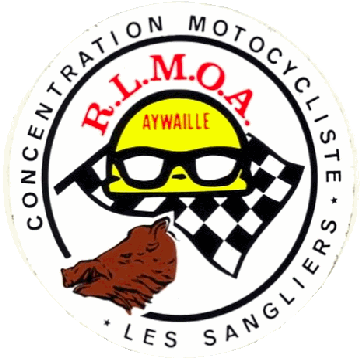
Two for the price of one
Given the history of this region, it wasn't surprising then that the RLMOA, (Royale Ligue Motoriste Ourthe-Ambleve) of Aywaille, one of the oldest Belgium clubs, founded way back in 1921, adopted this logo for their annual rally badge. It depicts the Ardennes boar underneath the chequered flag with a helmet superimposed on top.
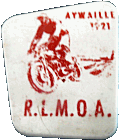
Since its formation, the RLMOA Aywaille has for the most part undertaken the promotion of trials in Belgium, covering many premier events including the organisation of the world championships. However, it's international recognition mainly stems from organising the famous 'Sangliers' rally which takes place every year at the beginning of July, on the Francorchamps circuit, the day before the Belgium Grand Prix.
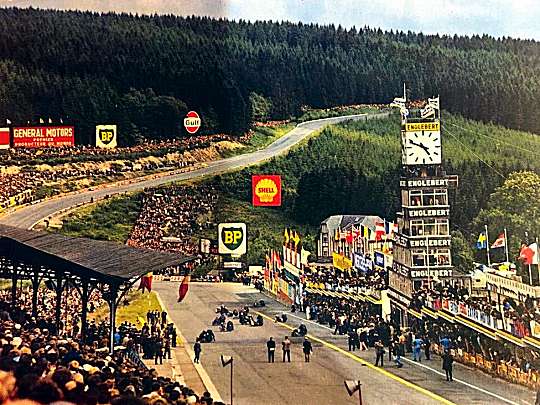
Belgium Grand Prix on the circuit of Francorchamps
There are many rallies organised to coincide with a Grand Prix or endurance race. The Belgian Speed Grand Prix was no exception. After all, the recipe is effective and works very well. Not only does it allow the organising club to attract a large number of registrants, but is a great source of income, all the more so due to the allied meeting.

This proved to be a win-win situation since for their part the Sangliers rally attendees were happy to be able to take part in another rally while also benefiting from added extras included in the ticket price. These included the right to use the campsite, park near the circuit, the entrance ticket itself, refreshments, various stickers including the one commemorating the event, and the collector's rally badge.
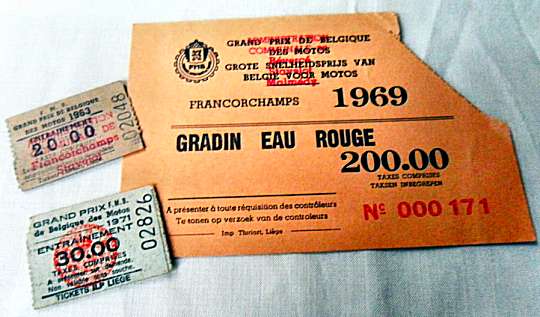
Belgium Grand Prix entrance tickets
Sangliers rally in the early 1970s
At the very beginning of the 1970s, apart from the Belgian rallyists, the next greatest numbers of foreign attendees were French, which seemed perfectly logical given the proximity to each other's country. On the other hand, there was a scarcity of Brits, but oddly many Scandinavians, mainly Swedes.
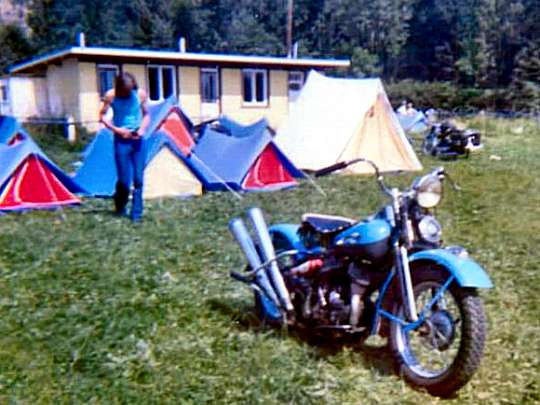
Sangliers 1971 - View of the campsite that year on the grass of the local sports stadium
At the time, rallyists arriving in Aywaille could register at the RLMOA headquarters located in a bar in the town. For the sum of 230 Belgian francs, (roughly £5 at the time), each participant received the rally badge, the right to the campsite, the entry ticket to the Belgian Grand Prix the next day, a parking ticket for their machine, a voucher for a drink, and various stickers including the rally sticker.
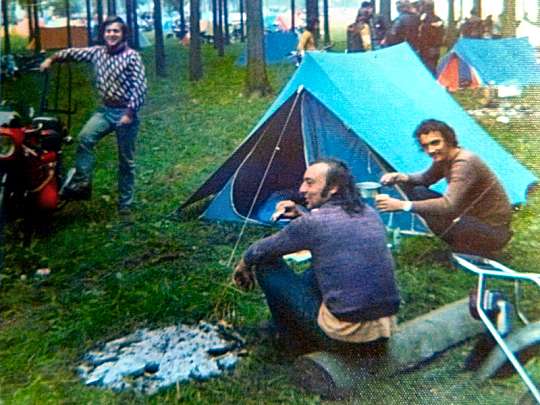
Sangliers 1975 - On waking up on Sunday morning, a good cup of black coffee is very welcome after an over indulgence of Belgian beer the night before
Saturday evening saw rallyists form up into a procession to lay a wreath at the FMB memorial, a monument erected in Aywaille in honour of Belgian motorcyclists who had died while racing.

Memorial FMB
This particular monument has a motorcycling history that is fascinating in itself and I should like to briefly outline the background to its story.
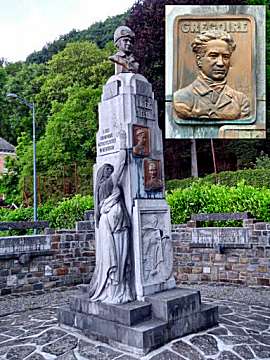
The Memorial FMB in Aywaille. Above, in a frame, the portrait of Robert Gregoire on the monument plaque
A native of Aywaille, Robert Gregoire (1901-1933) developed a passion for motorcycle racing in the aftermath of the Great War. After winning his first trophies on his own machine, this professional mechanic became a factory rider when Sarolea hired him at the end of the 1920s.
He was crowned champion of Belgium in the 500cc class in 1932 and 1933, setting several lap records on the competition circuit. He also established a world record; that of the standing start kilometer run. Unfortunately though this quest for pure speed cost him his life on 21 July 1933, when he tragically died during testing on the Francorchamps circuit.
The mid-30s were catastrophic for elite Belgian speed riders. Apart from Gregoire, three other great Belgian racers were killed: Pol Demeuter and Eric 'Noir' Haps (both FN factory racers) in 1934 and Antoine Lambert in 1935.
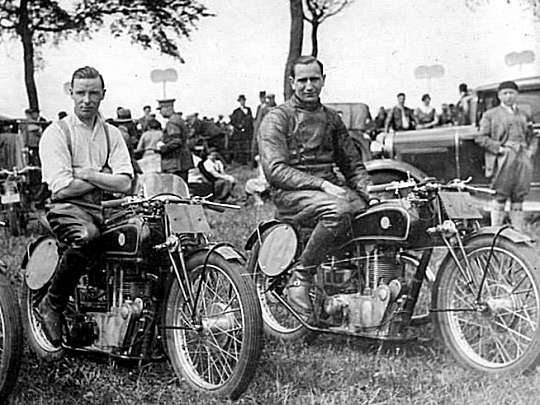
FN factory racers Pol Demeuterre (left) and Eric 'Noir' Haps (right), posing here on their 500cc machines, both died in competition in 1934
The RLMOA club erected a commemorative monument in memory of Robert Gregoire in July 1935. Its inauguration was made in the presence of numerous Belgian and foreign delegations, local authorities and Belgian motorcycle clubs.
After World War II, with the support of the Belgian Motorcycling Federation, it was decided that the RLMOA would take over the restoration and maintenance of the monument which then turned into a memorial, (shown in the video below) dedicated to all Belgian racers who had died in competition.
On 8 June 1958 the monument was re-dedicated. A large motorcycle rally under the aegis of the FMB and the RLMOA was organised in Aywaille.
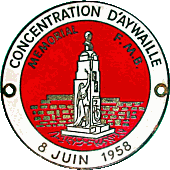
This occasion, to commemorate the event, attracted rallyists from all over Belgium as well as more distant countries. Fortunately, a commemorative badge from this meeting has survived for more than six decades so I can share it with you today.
The Sangliers rally changed location thereafter, whilst still remaining very close to its 1970s hometown roots. In the early 1980s, the annual meeting was held in the village of Harze, 4km south of Aywaille.

I have no idea fifty years later if this rally still exists.
Addendum
Whilst recently researching a little further into the Belgian racers mentioned in my previous article, I came across this old Belgian postcard published around 1946.
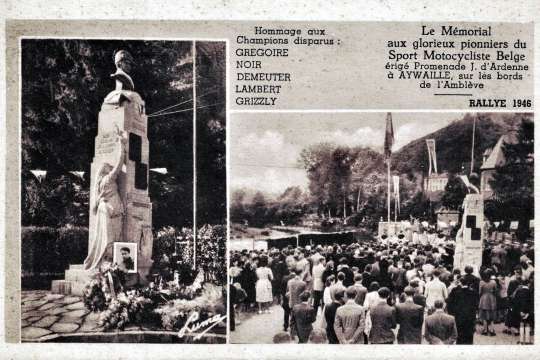
The caption to the right of the postcard, (showing the group of participants gathering at a ceremony at the FMB monument), states that it was taken during the Aywaille rally of 1946.
This conclusively proves that, 25 years prior to the Sangliers rallies in the 1970s and shortly after the end of WW2, the RLMOA Aywaille had already organised such a rally.
- Jean-Francois Helias